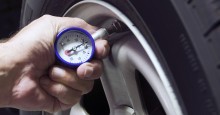
Mechanic with checklist for vehicle. Photo ID 166652811 © Shutter2u | Dreamstime.com

Check tire pressure. Photo ID 12598456 © Jcpjr | Dreamstime.com
Your car is more than just a mode of transportation–it's a reliable companion that gets you where you need to go, day in and day out.
And since it’s National Car Care Month, now is the perfect time to show your car just how much you care. While regular maintenance is essential, there are also some extra touches you can add to show your car you truly appreciate it.
Here are some simple yet meaningful ways to go the extra mile in caring for your vehicle. Car care tips that go the extra mile:
- Car inspection. The tough winter months can be extremely harsh on a vehicle. Don’t let those winter issues become bigger problems in spring by scheduling a multi-point inspection. Bring your vehicle to your trusted service advisor for a spring inspection, so they can identify small problems before they become expensive repairs.
- Alignment (potholes, road obstructions, curbs). As winter’s snow and ice begin to melt, the spring season reveals unwanted landmines on the road, including divots and potholes. Hitting a pothole, even at low speeds, can be damaging for your tires and also affect your car’s handling and alignment. While drivers make the effort to avoid potholes, oftentimes they are unavoidable. Because of this, it's a good idea to have your car's alignment checked by a professional technician. Proper wheel alignment is crucial for ensuring even tread wear on your tires, optimal steering control and handling, and maximum fuel efficiency.
- Check for winter damage to your tires. After the winter season, look for signs of wear and tear, damage, or uneven tread wear. Tires are an investment in your family’s safety, and a set of new treads are crucial when planning your next excursion. Ask your advisor to help recommend the right tires for the kinds of spring and summer outings you are planning. Make sure your tires have the proper inflation. Improper inflation can lead to uneven tire wear or potentially blowouts. Tires lose up to 3 PSI per month. And always be sure to inspect your spare tire as well.
- Test your battery. Have your battery tested by a professional to ensure it's in good condition. Fluctuations in temperature often provoke issues with car batteries, especially during colder weather, which can quickly deplete battery power. Listen to your vehicle when it starts in the morning. Does it struggle to turn over? This might be a sign your battery is about to die.
- Do you hear squeaks and squeals coming from your wheel wells? Test your vehicle brakes to make sure they are in good condition. If you notice a high-pitched whine, have your brakes inspected promptly. Also, if your brake pedal goes all the way to the floor, go straight to your service center. If the brake system isn’t responding promptly, there could be a leak in the brake lines. Have your service advisor check the brake pads, rotors, and brake fluid levels as well.
- Replace cabin air filters to cut down on spring allergens. A clean cabin air filter enhances the interior air quality of your car, minimizing allergens for a healthier cabin environment. Replacing the cabin filter is an inexpensive way to help reduce pollen and other contaminants.
- Inspect car hoses and belts. Cold winter temperatures can lead to cracks in engine hoses and belts. Cracked hoses can turn into major leaks as the days get warmer. Plus, squealing belts or cracked belts can hinder your engine from running properly.
- Change out your wiper blades. Winter can wear out your wiper blades, and those worn-out wipers can smear spring grime, reduce visibility and scratch your vehicle windshield. Ask your service advisor to recommend the best blades for spring and summer driving, which have different requirements than winter driving.
- Top off fluids, especially windshield wiper fluid. During the cold winter months, the continual use of windshield wiper fluid to remove snow, road salt, grime, and ice can quickly deplete your supply level. As winter fades and spring emerges, now is an excellent time to check your vehicle's fluid levels, especially your windshield wiper fluid. Plus, with spring rains and increased pollen in the air, a topped-off reservoir of washer fluid will help keep your windshield clean and streak-free.
- Fix the cracks in your windshield. The harsh winter weather can kick up a lot of debris, especially as things begin to melt. If you have a crack in your windshield, attend to it immediately as warmer weather can cause chips to spread into a larger, vertical crack.
- Repair or replace damaged headlights. Inspect your vehicle for blown-out and dull bulbs. Replacing bulbs is an inexpensive step that is fast and easy to do. If yellowed, this can reduce visibility and may be restored/cleaned rather than replaced. Inquire with your service advisor regarding the repair of any damaged headlights to enhance visibility during nighttime driving.
Copyright © 2024 by Sensible Driver. All rights reserved.